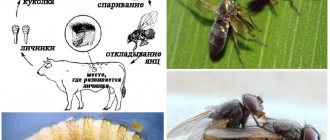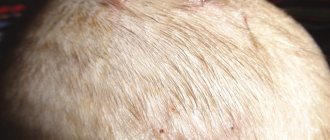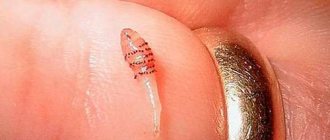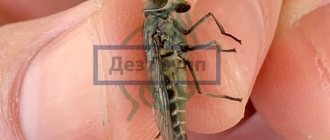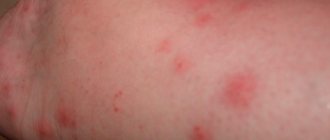There are about 150 species of gadfly larvae in the world. Fortunately, only one of them is dangerous to humans. Its habitat is the territory of planet Earth with a tropical climate. In general, this parasite is very dangerous if it enters the human body. Therefore, you should be careful and, when the first signs appear, immediately and immediately contact a specialist.
What is a gadfly larva?
It is a parasite that mainly develops and grows under the skin of a person or animal. The larva of the gadfly resembles a pear with thorns on its scales. Their length is small - slightly less than 30 mm, and their diameter is about 8 mm. The parasite feeds on blood. This is why it is dangerous if it enters the human body. This harmful microorganism attaches to mammalian tissues using hangnails. And in this way it feeds, that is, it accumulates useful substances for its further existence and vital activity. In addition, after entering the body of a mammal, it can secrete a peculiar liquid that causes severe pain.
Myiasis - what is it, types of diseases
The larvae of some types of flies that penetrate the skin of people and animals cause a dangerous disease - myiasis. It is characterized by the destruction of tissues and cavities of human internal organs and is accompanied by concomitant diseases and infections. In people, the reason for their appearance is non-compliance with hygiene rules, their own negligence and carelessness.
Important: fly larvae are extremely tenacious; some are capable of not only remaining alive for a long time in alcohol or formaldehyde, but also developing successfully. This property helps them survive in the hostile environment of the human intestine.
There are three types of myiasis infection. They depend on the type of parasite and the method of infection.
- In case of accidental infection, the causative agent is the larvae of flies found in rotting organic matter and clothing, linen, and food. They enter the human body through dirty hands, underwear, and with food.
- Obligate - caused by larvae of flies that lead a parasitic lifestyle and reproduction, most often leading to skin myiases.
- Facultative - a method in which flies, house flies or blow flies, lay eggs in damaged human tissue.
This is important: the causative agents of myiasis are only 18 species of flies living in tropical countries of the Southern Hemisphere and several species living in the European part of the globe.
What types of gadflies exist?
There are a huge number of types of this parasite. Experts agreed to subdivide them according to their habitat. Each type of larvae has its own characteristics. Some of them are dangerous for the owner and his body. There are 4 types of parasites: subcutaneous and cutaneous, cavitary and gastric.
The first type is dangerous for both humans and animals. If treatment is not timely, disastrous consequences can occur.
The second type is characteristic of the bull gadfly. It is, of course, not dangerous like the first type, but still, if this happens, boils form on the body of a person or animal. In addition, severe pain appears. Pus may then be released.
The cavity type is most common in goats. The larvae are first found in the nostril, and then penetrate the respiratory tract.
Gastric botfly most often occurs in horses. It develops in their stomach, and then moves to the tongue and gums. Pustules form there.
Classification of myiasis by type
The classification of myiases is carried out depending on which organ of the human body is affected by the parasite. There are such types of diseases: subcutaneous, strip, intestinal, ophthalmic, genitourinary, African. The development of the disease occurs very quickly, so timely treatment is necessary.
Cutaneous (tissue) myiasis
The most common type of disease, in appearance it resembles furunculosis. Accompanied by discomfort from itching, burning and pain in the affected areas of the skin. It can be epidermal - located in the upper layers of the skin and subcutaneous.
In the first case, the parasites do not leave the epidermis. When subcutaneous, it can affect the soft tissues of the body, which can lead to the destruction of entire parts of it. This form of the disease is difficult to treat and can be fatal.
Oral, ear, nasal
With this type of infestation, fly larvae penetrate into the soft parts of various parts of the body and destroy them. The oral cavity and its soft parts are most often affected. Against the background of chronic ear diseases, stripe myiasis of the auditory canal may occur.
The larvae destroy the eardrums and reach the brain, which leads to encephalitis and death of the patient. Infection occurs during sleep or through contaminated underwear.
Intestinal
Fly eggs enter the gastrointestinal tract along with food: vegetables and meat, even heat-treated meat. It could even be ready-made dishes that have been infected by a fly. Parasites do not die in the human stomach, but spread throughout the entire digestive tract.
The patient experiences attacks of nausea, vomiting and severe abdominal pain. In some cases, larvae can be seen in vomit and feces. In advanced stages, internal bleeding occurs.
This is important: occasional intestinal myiasis can be caused by the larvae of common houseflies, houseflies, green and blue blowflies.
Ocular myiasis
Fly larvae infect the conjunctival sac, make passages in the walls of the eyeball, tear ducts, destroying the eye. In this situation, passive infection of humans can occur. The patient's visual acuity decreases and his vision worsens.
In an advanced state, there may be blindness and loss of an eye. The disease is treated with surgery and antibiotics.
Urogenital
Fly eggs enter the human body through contaminated linen or household items. They cause diseases of the genitourinary system. The larvae infect the internal and external genital organs and the urinary tract.
This leads to serious complications, inflammatory and purulent processes. There is itching in the genital area, pain when urinating. The disease can lead to malignancy.
This is interesting: the cause of the disease is the mangrove fly that lives in the Congo Nature Reserve. She lays eggs even on vertical surfaces. Many tourists who are not familiar with this fact can get sick if they hang wet laundry on a line. Locals practice drying clothes in a horizontal position.
African
The larvae of the fly Cardylobia authropophaga, once on human skin, penetrate the body and cause African myiasis. The peculiarity of this fly is that it lays eggs in sand or soil watered with urine. The emerging larvae cling and bite into the skin of animals and people who walk barefoot or sunbathe on the sand.
How can a parasite enter the human body?
The adult gadfly larva is a fly. Its size is about 2 cm. It is somewhat similar to a bumblebee.
But to distinguish it from this insect, there are a number of signs:
- big head;
- large eyes;
- blue belly;
- orange paws;
- transparent wings.
The grown parasite does not eat anything, but feeds on the substances that it accumulated when it was still a larva.
Already half a minute after emerging, an adult gadfly can fly. A female individual produces about 600 eggs. But, fortunately, only 1/6 survive.
The adult parasite catches blood-sucking insects and then leaves its eggs on their abdomens. And if a mosquito carrying these larvae lands on a person or animal, then they penetrate into their body. People do not experience any pain or discomfort.
Parasites that have matured have special devices - hooks. With their help they attach to the skin. Bodfly larvae in humans feed on blood throughout their stay and grow up to 2.5 cm. In total, this parasite lives in the body of a mammal for about 9 weeks. Afterwards it comes out and falls to the ground, where the pupation process occurs. A month later an adult appears.
Does this parasite exist in Russia and can you become infected with it?
There are about 7 species of larvae in our country. They mainly live in the body of cattle. There are known cases where gadfly larvae were found in the human body in Russia. Their favorite place to be is the eyes or skin.
Of course, the percentage of cases of this parasite being found in people is very low, but you should beware of these harmful creatures. You should be aware and know the signs of the disease when they enter the human body.
Danger for pets
Bodfly larvae can also appear in dogs. The most likely sites for infestation in this case are areas where tall grass grows and there may be a sufficient population of rodents.
On a note! Even puppies that have never been outside can become infected with the larvae of the subcutaneous botfly. In this case, the cause of infection will be their mother, who brought the parasites on her fur!
Treatment
When dogs are infected with the subcutaneous botfly, treatment will depend on what stage of development the parasites are in.
- Safe removal of the larva from the pet's body is possible provided that the parasite has already completed its migration and stopped in a certain place. Moreover, it can be found not only in the back area, as in most cases with cattle, but also in the nose and eye.
- If the larva of the subcutaneous gadfly is still at the first stage of its development and is still migrating in the body, then in this case it would be advisable to use one of the antiparasitic drugs with a wide spectrum of action. Such products can neutralize insects and alleviate symptoms if parasites are suspected of moving to the animal’s lungs.
- If the latter diagnosis is confirmed, then corticosteroids are often also prescribed.
Important! It is advisable to detect the subcutaneous gadfly in the dog’s body as early as possible. If you delay, the parasite's activity can lead to irreversible neurological damage. And if the prognosis is particularly bad, the only option is euthanasia!
Prevention
If your pet has a weak immune system, then infection with subcutaneous botfly larvae can occur annually. To prevent this, you can resort to the following preventive measures:
- during periods of high activity of the gadfly, do not walk in areas with dense, tall grass;
- Before going outside, treat the dog’s fur and body with antiparasitic drugs, preferably broad-spectrum;
- Constantly inspect your pet’s body for the presence of lumps and, if any are found, immediately contact a veterinarian.
Pay attention to your dog's behavior as well. If she constantly scratches a certain place, then it is quite possible that the larva of the subcutaneous gadfly is now trying to penetrate there. In this case, it is advisable to conduct another inspection and, if there are no visible damages, treat the area with an antiparasitic drug.
Symptoms when a parasite is under the skin: what are they?
The gadfly larva can be anywhere in a person. For example, it can be found on the arm, on the chest, on the leg, and even on the head. But their most favorite places to live are the armpits and back. It also happens that the larva of a gadfly in the body is located in the nose or eye.
As a rule, at first a person does not experience any complications or discomfort. In the place where the parasite entered, a small bump appears, reminiscent of a mosquito bite. After a certain amount of time has passed, this area begins to hurt and become inflamed. Afterwards it turns blue or red. Then an abscess forms and opens. Thus, for the gadfly larva, a certain hole is formed under the human skin through which the parasite breathes. As soon as the inflamed area is opened, pus begins to be released from it.
After this, the person’s condition begins to deteriorate sharply. Nausea or vomiting, weakness and dizziness, and muscle pain are the main symptoms of gadfly larvae entering the body. In the area where there is inflammation, the patient may feel something moving.
When these harmful parasites get into the eyes, irritation of the mucous membrane is felt, and eye pressure increases. There is constant lacrimation. In addition, all these signs may be accompanied by pain and bleeding.
The penetration of larvae into the vitreous body of the eyeball is very dangerous. Then the person may lose his sight completely.
When the parasite is in the body, the following symptoms are present:
- headache;
- deterioration of sense of smell;
- swelling of the nose;
- pain at the location of the larva.
Surprisingly, these harmful microorganisms can crawl out through the nostril.
Danger to humans
Sometimes a gadfly can end up under a person's skin. This type of insect is called Dermatobia hominis. Their migration in this case ends, as a rule, with penetration into the head. This is quite dangerous, especially if the parasite managed to get to the eyes. If subcutaneous gadfly larvae are detected in the eye, ophthalmomyasis is diagnosed and an operation is performed during which the parasites are removed. In most cases, this situation ends in partial loss of vision.
In addition, as a result of its vital activity, the larva of the subcutaneous gadfly provokes the development of dermatobiasis. This disease manifests itself in the form of nodes that appear in the area where the insect is present. These nodes can become inflamed and cause suppuration. After some time, mature individuals leave the body of their host.
On a note! A person can become infected with the larvae of the subcutaneous gadfly only during his stay in Central and South America! This type of parasite has not been found in our country!
How is diagnosis made?
The main method is to take a blood test. It determines the amount of antibodies. The patient is also asked a number of questions. For example, they ask whether he has been to places where the disease is common. In addition to all this, the specialist conducts a visual inspection. Using this method, you can detect an inflamed purulent abscess. It has a hole through which air flows. The doctor examines the area using a special device, namely a magnifying glass.
If you are absolutely sure that there are gadfly larvae in the body, then you should not contact a therapist, but immediately an infectious disease specialist.
How is treatment carried out when infected with larvae?
After these parasites enter the human body, certain signs of a disease called dermatobiasis appear. The treatment itself involves the direct removal of the larva from the patient’s body. But you can’t do this right away.
Before removing the gadfly from under a person’s skin, it is necessary to drink the drug “Ivermectin”. It is antiparasitic. Only after this can you proceed to the next action.
Operation to remove helminths from under the skin
Identifying such parasites can be difficult, since conventional diagnostic methods do not always detect worms in the body. Subcutaneous worms are in the incubation stage for a long period; they may not make themselves felt for several months or for many years, so the patient cannot always accurately determine the moment when the infection occurred.
In addition, doctors often mistake the bumps that form on the skin for symptoms of other diseases, which is why they prescribe the wrong treatment.
An infectious disease specialist or parasitologist can accurately determine the disease. If subcutaneous invasion is detected, surgical treatment is prescribed.
Surgery is considered an effective way to remove worms from subcutaneous tissues.
Since such worms do not have the ability to reproduce in the human body, surgical treatment eliminates the symptoms of infection and completely eliminates helminthiasis.
Removing gadfly larvae: how does it happen?
Before removing the parasite from under a person’s skin, the abscess site must be disinfected. This is usually done using a solution of furatsilin. To prevent the larva from breathing, a certain amount of sterile oil is dripped into the hole from which the air flow penetrates. After this, the gadfly must leave, as it lacks oxygen. At the moment when the parasite appears from the hole located under the skin, it is pulled out using a special device (tweezers).
A complex operation should only be performed by a specialist. The gadfly itself is located in very deep layers of the epidermis. As mentioned above, it is located there thanks to the hooks. If the patient himself tries to perform this entire procedure, it is possible that part of the larva will remain under the skin. With this outcome of events, suppuration and an inflammatory process will follow.
As soon as the operation is completed, an antiseptic bandage is applied to the place where the abscess was previously.
Routes of entry into the host body
The subcutaneous gadfly is known for the fact that its larvae penetrate the skin of their host and migrate for some time in the tissues, causing parasitic diseases. But how do they get on the body of their owner? This is ensured by the female gadfly, which lays eggs on the skin of animals; most often, she attaches them one by one to the fur, and after a while the larvae emerge from them and penetrate under the covers.
Being at the first stage of their development, the larvae are constantly in the body of their host. As the second phase approaches, just before molting, they appear in the back area. During this period, nodules with fistulas—exit openings—will be visible on this part of the animal’s body. Thanks to them, the gadfly larvae located under the skin are able to breathe, and after a while they come out through these same holes.
Prevention of infection
But most often the gadfly larva penetrates the human skin in countries with a tropical climate. And if you decide to go there, then follow a few simple rules. Places where large numbers of insects live should be avoided. Of course, you need to wear clothing that will protect you from bites. Nowadays there is a huge selection of good repellents in stores. These should also be used.
If, for example, an insect bites you, you should not panic ahead of time, but you should not forget about it either. First, you should treat the wound with a disinfectant. And watch her. If something goes wrong, you must immediately contact a specialist. The doctor will examine you, if the diagnosis is confirmed, he will send you for the appropriate procedures, and if the opposite is true, you can safely return home. And don’t forget that vigilance never hurt anyone.
